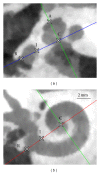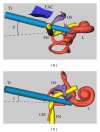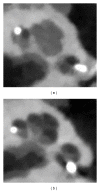Semiautomatic cochleostomy target and insertion trajectory planning for minimally invasive cochlear implantation
- PMID: 25101289
- PMCID: PMC4101975
- DOI: 10.1155/2014/596498
Semiautomatic cochleostomy target and insertion trajectory planning for minimally invasive cochlear implantation
Abstract
A major component of minimally invasive cochlear implantation is atraumatic scala tympani (ST) placement of the electrode array. This work reports on a semiautomatic planning paradigm that uses anatomical landmarks and cochlear surface models for cochleostomy target and insertion trajectory computation. The method was validated in a human whole head cadaver model (n = 10 ears). Cochleostomy targets were generated from an automated script and used for consecutive planning of a direct cochlear access (DCA) drill trajectory from the mastoid surface to the inner ear. An image-guided robotic system was used to perform both, DCA and cochleostomy drilling. Nine of 10 implanted specimens showed complete ST placement. One case of scala vestibuli insertion occurred due to a registration/drilling error of 0.79 mm. The presented approach indicates that a safe cochleostomy target and insertion trajectory can be planned using conventional clinical imaging modalities, which lack sufficient resolution to identify the basilar membrane.
Figures






Similar articles
-
In vitro accuracy evaluation of image-guided robot system for direct cochlear access.Otol Neurotol. 2013 Sep;34(7):1284-90. doi: 10.1097/MAO.0b013e31829561b6. Otol Neurotol. 2013. PMID: 23921934
-
Validation of minimally invasive, image-guided cochlear implantation using Advanced Bionics, Cochlear, and Medel electrodes in a cadaver model.Int J Comput Assist Radiol Surg. 2013 Nov;8(6):989-95. doi: 10.1007/s11548-013-0842-6. Epub 2013 Apr 30. Int J Comput Assist Radiol Surg. 2013. PMID: 23633113 Free PMC article.
-
Anatomy of the middle-turn cochleostomy.Laryngoscope. 2008 Dec;118(12):2200-4. doi: 10.1097/MLG.0b013e318182ee1c. Laryngoscope. 2008. PMID: 18948831
-
Cochleostomy site: implications for electrode placement and hearing preservation.Acta Otolaryngol. 2005 Aug;125(8):870-6. doi: 10.1080/00016480510031489. Acta Otolaryngol. 2005. PMID: 16158535 Review.
-
Cochlear implant electrode insertion: in defence of cochleostomy and factors against the round window membrane approach.Cochlear Implants Int. 2011 Aug;12 Suppl 2:S36-9. doi: 10.1179/146701011X13074645127478. Cochlear Implants Int. 2011. PMID: 21917217 Review.
Cited by
-
Instrument flight to the inner ear.Sci Robot. 2017 Mar 15;2(4):eaal4916. doi: 10.1126/scirobotics.aal4916. Sci Robot. 2017. PMID: 30246168 Free PMC article.
-
First use of flat-panel computed tomography during cochlear implant surgery : Perspectives for the use of advanced therapies in cochlear implantation.HNO. 2017 Jan;65(1):61-65. doi: 10.1007/s00106-016-0213-z. HNO. 2017. PMID: 27534759 English.
-
[Surgical simulation on the lateral skull base].HNO. 2017 Jan;65(1):13-18. doi: 10.1007/s00106-016-0202-2. HNO. 2017. PMID: 27393291 Review. German.
-
Image-guided cochlear access by non-invasive registration: a cadaveric feasibility study.Sci Rep. 2020 Oct 27;10(1):18318. doi: 10.1038/s41598-020-75530-7. Sci Rep. 2020. PMID: 33110188 Free PMC article.
-
Robust Cochlear Modiolar Axis Detection in CT.Med Image Comput Comput Assist Interv. 2019 Oct;22:3-10. doi: 10.1007/978-3-030-32254-0_1. Epub 2019 Oct 10. Med Image Comput Comput Assist Interv. 2019. PMID: 32002521 Free PMC article.
References
-
- Bell B, Gerber N, Williamson T, et al. In vitro accuracy evaluation of image-guided robot system for direct cochlear access. Otology and Neurotology. 2013;34(7):1284–1290. - PubMed
-
- Adunka OF, Dillon MT, Adunka MC, King ER, Pillsbury HC, Buchman CA. Cochleostomy versus round window insertions: influence on functional outcomes in electric-acoustic stimulation of the auditory system. Otology & Neurotology. 2014;35(4):613–618. - PubMed
-
- Aschendorff A, Kromeier J, Klenzner T, Laszig R. Quality control after insertion of the nucleus contour and contour advance electrode in adults. Ear and Hearing. 2007;28(2) supplement 2:75S–79S. - PubMed
Publication types
MeSH terms
LinkOut - more resources
Full Text Sources
Other Literature Sources

